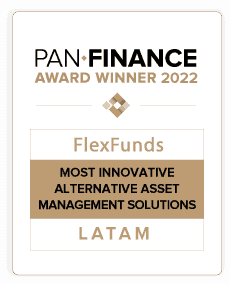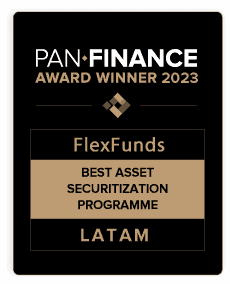- In this article, you will find information about the advantages of structured notes linked to underlying assets for investors and the factors to consider to minimize their risk.
- The information in the article is useful for investors considering investing in structured notes as an instrument that allows them to maximize their investment with limited risk.
- FlexFunds specializes in the set up and issuance of investment vehicles. Innovative and customized solutions can be offered thanks to the characteristics of FlexFunds’ structured notes. Contact our team to find out which solution suits your needs.
What are Structured Notes Linked to Underlying Assets and How Do They Work?
Structured notes are hybrid investment products, with a predetermined maturity date, created by combining various financial instruments, shaping a unique and indivisible structure. This allows for better returns than fixed-income products and greater hedging against risk. They are a versatile type of structured product that belongs to the family of ETPs and can be tailored to the investor’s risk profile and needs.
In addition to understanding the need that a structured note covers and the advantages it offers, it is also necessary to indicate some of the main factors that characterize them, such as the underlying assets to which they are linked, the maturity date, profitability, and protection and guarantee mechanisms that aim at minimizing risk as much as possible.
Therefore, structured notes linked to underlying assets are financial instruments that combine characteristics of bonds and derivatives, i.e., fixed income and variable. These notes are issued to provide investors with specific returns based on the performance of a portfolio of diverse financial assets. In fact, the quoted price of this instrument will depend on various factors, with the underlying asset playing an important role.
On the other hand, it is difficult to explain how a wide range of structured notes work. However, generally, they can be classified as income or growth-structured notes. While the former pays a conditional periodic coupon until maturity and then return the initial capital, the latter return the initial capital and any profits (if there are any) at maturity.
Likewise, structured notes can be designed with capital protection at maturity (capital-protected), allowing for the recovery of the entire investment, or without protection, with the performance of the note being conditioned by the behavior of the underlying assets.
Types of Underlying Assets
As mentioned, a structured note usually comprises two types of underlying components: one associated with a debt instrument, which can be issued by a financial institution, such as a bond, and another derivative component that adjusts the risk-return relationship. Therefore, the performance of a structured note is usually linked to the behavior of its set of underlying assets.
Although there is a wide variety of associated underlying assets, as well as combinations of these, the following are among the most common assets on which the derivative of a note is created:
- Stocks: when they are linked to the performance of individual stocks or a basket of stocks, either through the stock price, dividends, or a combination of both.
- Currencies: they are linked through fluctuations in the relative exchange rates of different currencies.
- Interest Rates: when the underlying asset is government or corporate debt bonds whose returns are determined by the interest rate they offer. They can include features such as options on bond performance or conditional coupons.
- Indices: whether they are stock market indices such as the S&P 500, NASDAQ, DJIA, or diversified baskets of commodities such as the BCOM Index, fixed income indices that depend on bond performance, real estate prices, volatility indices like the VIX from the CBOE measuring market sentiment. Returns can be obtained based on their value at a specific maturity date or during a specific period.
- Commodities: through the price variation of commodities or a basket of commodities in the markets, such as oil, gold, silver, and food, among others.
- Investment Funds: linked to their performance.
Factors Determining the Risk of a Structured Note
Structured notes have undeniable benefits for investors and financial decision-making. However, they are not exempt from risks that need to be considered. When an investor purchases a structured note linked to a series of underlying assets, they have high exposure to both the performance of those assets and the specific payment structure of the notes.
Since structured notes linked to underlying assets are complex financial products, they are not suitable for all investors and carry inherent risks that can be difficult to understand. Therefore, if you are interested in investing in structured notes, it is recommended to fully understand all the terms and associated risks before making any decisions. You can receive specialized advice on these types of products from FlexFunds’ team of experts whom you can consult.
Thus, the investment risk in this type of financial product is influenced by several factors:
- Underlying Asset Risk.
The performance of the underlying assets has a direct impact on the returns of structured notes. If the underlying assets experience significant changes in value, either upwards or downwards, this will affect the value of the notes, potentially leading to a loss of investment. For example, if a structured note is linked to a basket of stocks and the value of those stocks decreases, the note’s value will also decrease. - Capital Protection.
Some structured notes offer partial or total protection of the invested capital. This means that in case of adverse events in the underlying assets, investors may receive at least part of their initial investment back. The presence of capital protection can help mitigate the risk of loss to some extent. - Payment Structure.
Structured notes can have complex payment structures designed to offer potential returns higher than traditional instruments. These structures may include features such as conditional coupons, participation in the growth of underlying assets, or protection barriers. The payment structure of a note can affect both the potential return and the level of risk. It is important to fully understand how the payment structure works before investing. - Credit Rating.
Structured notes are issued by financial institutions, and therefore, the credit quality of the issuer is an important factor to consider. The credit rating provided by specialized agencies can indicate the likelihood of the issuer meeting interest and principal payments as agreed. - Liquidity.
Liquidity is an important aspect to consider when investing in structured notes linked to underlying assets. These instruments may have limited liquidity compared to more traditional financial instruments. This means selling the notes before maturity may be difficult if immediate access to the invested funds is needed. The lack of liquidity can have implications for investors’ ability to manage their portfolios.
Tools and Analysis Strategies for Decision-Making
The complexity of a structured note associated with assets arises from the difficulty of understanding the combined behavior of the elements that structure it and identifying, analyzing, and valuing the linked derivative financial instruments, whether they are options or futures. In this regard, for decision-making, the following aspects should always be considered:
Investment Objectives.
An analysis should be conducted to determine if structured notes are the most suitable financial product for the investor’s risk profile, portfolio diversification strategy, and investment horizon.
Understanding the Operation.
Before investing in a structured note, a thorough understanding of the details and implications of this type of product and its operation and associated risk is necessary.
Analysis of Underlying Assets.
A comprehensive analysis of the associated underlying assets should be carried out, evaluating their historical performance, volatility, and sensitivity to other factors.
Diversifying Note Portfolio.
Diversifying investments in different types of assets and financial products is recommended, avoiding placing all funds in a single note linked to specific assets.
Evaluating the Note Issuer.
Evaluating the creditworthiness of the issuer of the structured note is crucial. This can be done by analyzing financial strength, reputation, and credit ratings from rating agencies. If the issuer defaults on debt payments, there is a high risk of losing the entire invested capital.
Analysis of the Business Environment.
The price of structured notes is affected by environmental changes, such as economic growth, central bank macroeconomic policies, inflation, specific geopolitical conflicts, or climate disruptions that can affect commodity scarcity. While uncertainties in the business environment can have a negative impact on equities, high-interest rates will have a positive impact on recently issued fixed income.
Professional Advice.
Investing in structured notes involves risks, so it is advisable to seek advice from a professional expert in this type of product who can assess the specific circumstances of each investor and provide recommendations.
If you have any questions, you can contact one of our financial experts to make an inquiry.







